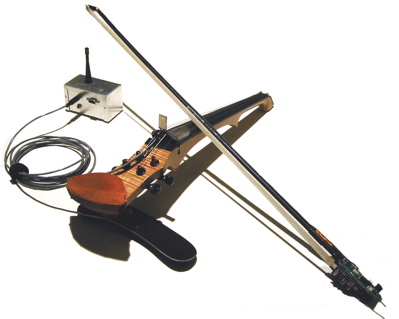[ Lay Language Paper Index | Press Room ]
Studying Violin Bowing
Diana Young - young@media.mit.edu
E15-443g
Media Laboratory
MIT
Cambridge, MA 02142
Popular version of paper 5aMU12
Presented Friday morning, June 9th, 2006
151st ASA Meeting, Providence, RI
The violin is widely recognized as one of the most difficult musical
instruments to play. Fortunately for those who persevere through
years and even decades of difficult training, it is also considered to
be one of the most rewarding. Students of the violin, as well as those
who play viola, cello, and double bass, must acquire proficiency in
techniques for left hand (fingering) and right hand (bowing) that are
completely different from each other, and then they must learn to
precisely coordinate the two.
Though the left hand presents many challenges to a developing
violinist, it is generally agreed that greater difficulties are
encountered while mastering bowing. Like a singer's breath, it is the
movement of the bow that provides the loudness and duration of the
notes, as well as the articulations that distinguish different musical
expressions. Indeed, it can take months or years for a new student to
achieve a so-called "good tone" on an open (unfingered) string. This
seemingly simple task is a subtle negotiation between the speed with
which the bow is drawn, the force applied to the string, and the
distance between the bow and the bridge of the instrument. The
interaction of these three primary bowing parameters is a topic of
interest for many researchers working in bowed string acoustics, but
there have been few studies involving real bowing parameters produced
by actual players. This is in large part due to the difficulty in
measuring these parameters without adversely affecting the technique
we aim to capture.
To enable the investigation of various violin playing techniques, a
measurement system has been created that can be used to measure bowing
parameters in realtime, while maintaining the portability and
playability of a traditional violin and bow. This system consists of a
carbon fiber violin bow and electric violin on which a custom
electronics are installed. The bow sports a light and compact
electronics board featuring a set of gesture sensors, a small battery,
and an RF module used to transmit the gesture data. (An early version
of this system is shown below.) Together with the audio data provided
by the electric violin, the gesture data collected from this custom
system is recorded by a laptop computer.

Currently this experimental setup is being used to collect data from
advanced student violinists while they perform simple musical tasks
and demonstrate various standard bowing techniques, such as
détaché,
martelé,
spiccato.
To date, the study has included violinists from the Schulich School of Music of
McGill University and the Royal
Academy of Music, as well as several novice players. The data from
these sessions is currently being analyzed to help understand
distinctions between novices and experts, as well as differences
between technique among experts.
[ Lay Language Paper Index | Press Room ]